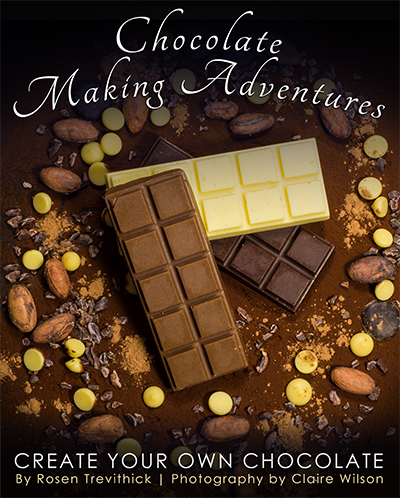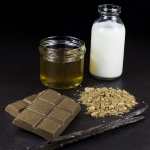Homemade Milk Chocolate Recipe
✔ vegetarian ✔ nut free
Although I found a handful of recipes for homemade milk chocolate online, none of them quite worked. They were always either gritty or the ingredients separated in the moulds. In my upcoming book, Chocolate Making Adventures, I will share lots of secrets on making the perfect, smooth milk chocolate. For those of you who can't wait, here's the basic recipe.
You will need chocolate moulds, yoghurt pots or plastic cups.
makes roughly 100g (e.g. two 80 x 100 x 9mm bars)
INGREDIENTS
55g cocoa butter
up to 5 tsp honey
up to 1 tbsp cocoa powder
2 tbsp powdered milk
METHOD
1. Start with a cool, dry kitchen.
2. Place the cocoa butter and vanilla chip in a heatproof bowl above a pan of boiling water. Stir from time to time, until melted. This may take longer than you expect.
3. Add half the honey and half the cocoa powder, then stir.
4. Milk powder won't dissolve into cocoa butter, so the trick is to make the powder so fine that the tongue cannot detect the grains. If your milk powder already has the consistency of flour, you can use it 'as is'. If not, put it in a coffee grinder for two minutes, or until perfectly smooth.
5. Stir the milk powder into the rest of the mixture.
6. Being careful to wipe any condensation off the bottom of the bowl, pour the mixture onto a slab, using a scraper and/or palette knife to ensure that it doesn't run off the edges.
7. Cool the mixture by working it back and forth with the scraper. Repeatedly spread it out to increase the surface area then scrape it back together. If the mixture doesn't start to thicken after five minutes, try opening a window to cool down your kitchen.
8. Taste your mixture. If it's not chocolatey enough, add cocoa powder, little by little. If it's not sweet enough, add a little more honey, continuing to mix with your scraper.
9. If you're happy with the flavour, then once the ingredients have combined smoothly and reached the texture of margarine, scrape it back into the bowl and return to the pan.
10. Stir until the chocolate is just thin enough to pour, or slightly thicker if you're going to use it for coating/filling. Allowing the chocolate to become too thin could cause the ingredients to separate in the mould.
11. Pour into moulds and transfer to the fridge immediately. Allow to set for one hour, or use as directed in your recipe. Store for up to four days in the fridge.
+














